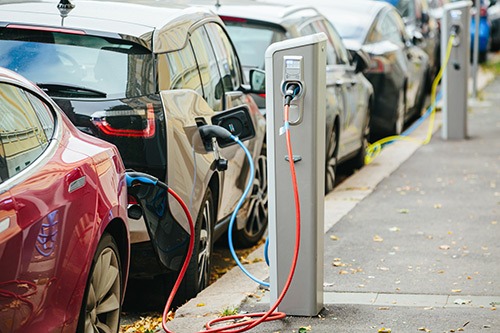For all fleet managers and businesses, the time is now to begin the transition to electric vehicles (EVs), and their thoughts should be focused on how rather than when. Many large organisations have already begun to add EVs to their fleets, including Amazon, DHL, and DPD, and many smaller businesses are following suit.
When compared with traditional fossil fuel-powered fleets, EV fleets can offer huge long-term savings on maintenance and fuel costs, a decrease in business emissions, and help improve your brand image.
What is an electric vehicle fleet?
An ‘electric vehicle fleet’ or ‘EV fleet’ is a collection of zero-emission vehicles owned or leased by a business for operational use. Fleet vehicles can be used for a variety of purposes, such as to make deliveries, transport goods, or provide company cars to employees. They can be any type of electric vehicle, as long as they’re 100 per cent powered by a battery (i.e., not hybrid or plug-in hybrid vehicles which use both a battery and fuel).
Unlike traditional petrol- and diesel-powered fleets, an electric vehicle fleet does not produce any harmful carbon emissions when it is operating. This is something that’s going to increase in importance in the near future as countries prioritise a move to “net-zero” by achieving an overall balance between emissions produced and emissions taken out of the atmosphere.
Given that there are plans for petrol- and diesel-powered vehicles to be phased out entirely in the not too distant future, in addition to the high likelihood that businesses that do not achieve carbon neutrality are likely to face additional taxation, it makes sense to begin making the switch sooner rather than later. Despite popular belief, there are plenty of options for business leaders when it comes to switching to an electric vehicle fleet, and the infrastructure that supports it is growing stronger with each passing month.
What are the advantages of having an electric vehicle fleet?
There are many compelling reasons that are influencing businesses to make the switch to electrified fleets early. Most notable among these is the potential for the business to save money, decrease carbon emissions, and attract and retain new customers and employees.
Reduced tailpipe emissions
EVs don’t need an exhaust pipe because they don’t produce any fumes. In a traditional engine, petrol or diesel is combusted which creates energy at the cost of producing harmful emissions. However, the batteries found in an EV are inherently free from these emissions.
The most common type of EV battery, lithium-ion, can go through thousands of charge cycles without directly producing air pollution. While there is an argument to be made that charging these batteries does create emissions, they’re minuscule in comparison.
Improved brand image and equity
Nowadays, consumers are far more concerned with how socially responsible the businesses that they buy from are. They want to know that the businesses that they are spending their money with care about the environment and sustainability, and that the business is taking steps to play their part in protecting it.
When consumers see that you have adopted an electric vehicle fleet, those who hold these values are more likely to become customers.
Save money
EVs are much cheaper to maintain than traditional petrol- and diesel-powered vehicles. That’s because they have fewer moving parts, don’t place as much of a strain on brake parts due to technologies like regenerative braking, and require no oil changes.
Aside from maintenance, there’s also the obvious elimination of fuel costs from the equation, which can make up as much as 80 per cent of the costs of a conventional fleet. There are also many tax breaks and incentives available; EVs don’t pay road tax, and the UK offers a benefit-in-kind tax of only 2 per cent whereas this can sometimes be above 30 per cent for petrol and diesel vehicles. Some of the other ways that an electric vehicle fleet can save your business money include the use of electric vehicle telematics systems and tax relief.
Making the switch to an EV fleet
Making the switch isn’t quick or easy. Having the right insight and strategies and working with the right partners will give fleet managers the power to deliver this critical transformation seamlessly.
An EV transition begins with the business knowing where it’s starting from, and three key considerations will help fleet managers establish this foundation:
- A comprehensive understanding of your existing fleet’s composition
- Being aware of the EV options available
- Cross-referencing vehicle requirements and EV options with replacement schedules
Just as important as choosing the right EV is investing in infrastructure. Charging infrastructure is a major issue for fleet managers, and while public charge points are an attractive prospect, there’s not enough supply to meet demand. According to recent statistics, around 26,000 UK public charge points offer capacity for just over 45,000 vehicles charging simultaneously. That’s clearly not enough. Businesses making the switch today should consider in-house charging infrastructure and using it to take a hybrid approach alongside public and home-based chargers.
Finally, fleet tracking remains a necessity, even for EV fleets. While early telematics solutions may have largely been driven by fuel efficiency concerns, modern solutions are packed full of features that provide EV fleet managers with oversight of metrics including state of charge, charging information, energy consumption, and more. This level of visibility is crucial for managers who need to find ways to increase battery life while driving down operational costs and optimising fleet performance.
Trakm8 is the first telematics solution on the market that has been optimised for both EVs and ICE vehicles. Read more in our Guide to Electic Vehicle Telematics.
Is your fleet ready for the transition to Electric Vehicles? Find out today by completing the free Electric Vehicle Suitability Assessment tool from Trakm8.
Get in touch with our team today and we’ll learn all about your business, fleet and daily operations to decide what telematics devices would provide the most value to you.


